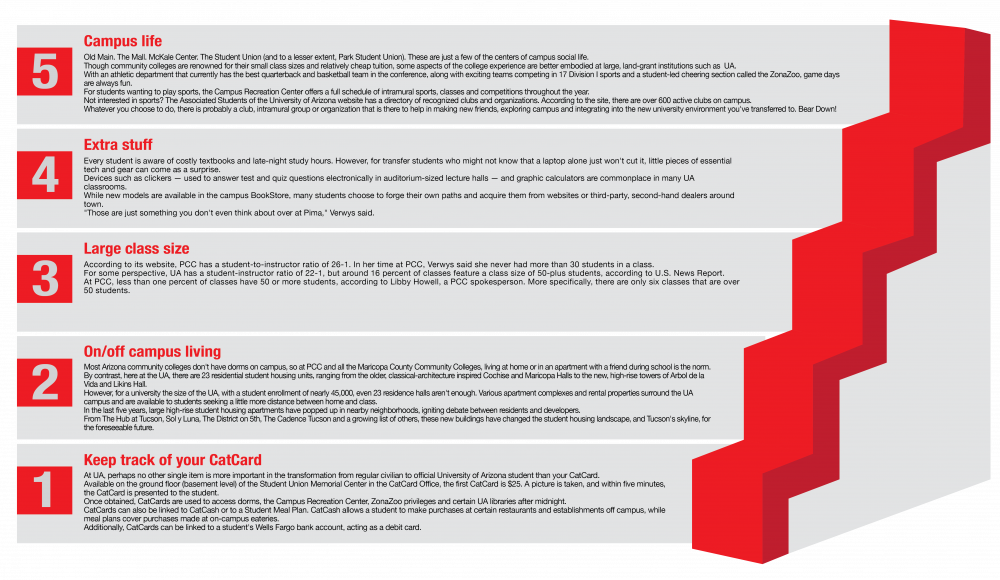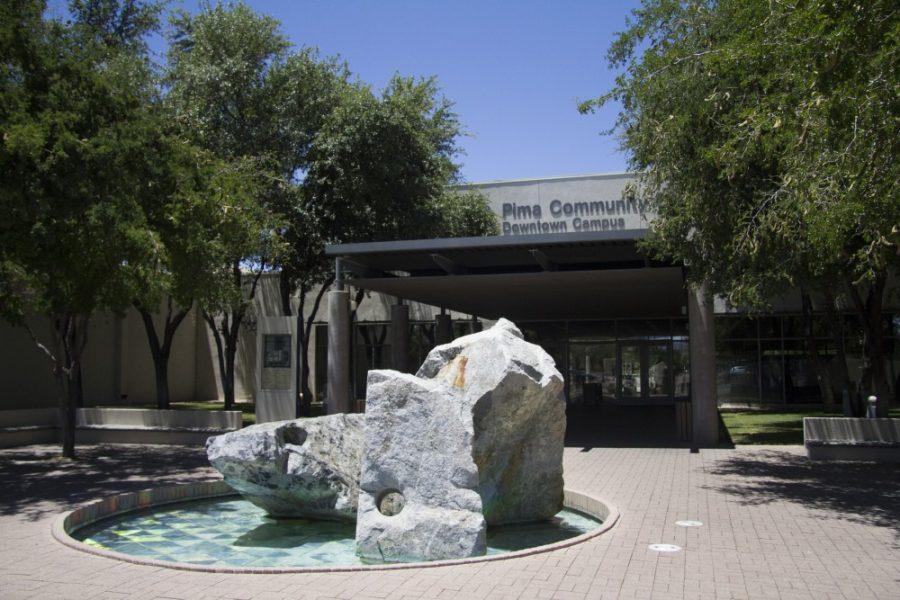Click here to read more content from our 2018 Orientation Guide!
Not every new student at the University of Arizona will be fresh out of high school. Some students take a gap year, and others return from the job market to obtain professional degrees. But a very significant part of the new student population are transfer students from one of the state’s 21 public community colleges.
Here at the UA, many of those transfer students hail from Pima Community College, the six-campus institution that enrolls 30,082 total students, 10,776 full-time and 19,306 part-time, according to a U.S. News Report.
Former Daily Wildcat editor Jamie Verwys counts herself as both a UA and PCC graduate. After spending a few years outside academia, Verwys returned to school at PCC in 2014.
While Verwys had also attended PCC right out of high school and been on track to earn a scholarship to an in-state, four-year university, her time off ____ that route.
“I definitely know there are programs and options that students who are transferring can take advantage of, though,” said Verwys.
One of those programs is UA Bridge, which guarantees admission into most UA undergraduate degree programs and the opportunity for a renewable $2,000 scholarship. The program is offered at most of Arizona’s community colleges.
Because community college transfer students already have anywhere from a few to more than 60 college credits to their name, there is the temptation to think the next two years will be similar to the last two.
Not quite, according to Verwys.
“Whereas at Pima I felt I was a little more on top of my schedule and able to do the kind of extra-curricular activities I felt I wanted to do, at UA I felt there was just so much going on,” she said.
RELATED: Taking the arts to the classroom
That’s why Verwys’ number one piece of advice to any incoming transfer student is to improve their time management.
“I wanted to do everything early on, and at Pima it was a little easier, time-wise,” she said. “Get a planner and find a club or activity you want to do and schedule it early. That way you find out what you can and can’t handle before it’s later in the semester.”
Along with this guidance from Verwys, here are five more pieces of advice for transfer students:
1. Keep track of your CatCard
At UA, perhaps no other single item is more important in the transformation from regular civilian to official University of Arizona student than your CatCard.
Available on the ground floor (basement level) of the Student Union Memorial Center in the CatCard Office, the first CatCard is $25. A picture is taken, and within five minutes, the CatCard is presented to the student.
Once obtained, CatCards are used to access dorms, the Campus Recreation Center, ZonaZoo privileges and certain UA libraries after midnight.
CatCards can also be linked to CatCash or to a Student Meal Plan. CatCash allows a student to make purchases at certain restaurants and establishments off campus, while meal plans cover purchases made at on-campus eateries.
Additionally, CatCards can be linked to a student’s Wells Fargo bank account, acting as a debit card.
2. On/Off campus living
Most Arizona community colleges don’t have dorms on campus, so at PCC and all the Maricopa County Community Colleges, living at home or in an apartment with a friend during school is the norm.
By contrast, here at the UA, there are 23 residential student housing units, ranging from the older, classical-architecture inspired Cochise and Maricopa Halls to the new, high-rise towers of Arbol de la Vida and Likins Hall.
However, for a university the size of the UA, with a student enrollment of nearly 45,000, even 23 residence halls aren’t enough. Various apartment complexes and rental properties surround the UA campus and are available to students seeking a little more distance between home and class.
In the last five years, large high-rise student housing apartments have popped up in nearby neighborhoods, igniting debate between residents and developers.
From The Hub at Tucson, Sol y Luna, The District on 5th, The Cadence Tucson and a growing list of others, these new buildings have changed the student housing landscape, and Tucson’s skyline, for the foreseeable future.
RELATED: Arizona Board of Regents: Day 1 wrap-up
3. Large class size
According to its website, PCC has a student-to-instructor ratio of 26-1. In her time at PCC, Verwys said she never had more than 30 students in a class.
For some perspective, UA has a student-instructor ratio of 22-1, but around 16 percent of classes feature a class size of 50-plus students, according to U.S. News Report.
At PCC, less than one percent of classes have 50 or more students, according to Libby Howell, a PCC spokesperson. More specifically, there are only six classes that are over 50 students.
4. Extra stuff
Every student is aware of costly textbooks and late-night study hours. However, for transfer students who might not know that a laptop alone just won’t cut it, little pieces of essential tech and gear can come as a surprise.
Devices such as clickers — used to answer test and quiz questions electronically in auditorium-sized lecture halls — and graphic calculators are commonplace in many UA classrooms.
While new models are available in the campus BookStore, many students choose to forge their own paths and acquire them from websites or third-party, second-hand dealers around town.
“Those are just something you don’t even think about over at Pima,” Verwys said.
5. Campus life
Old Main. The Mall. McKale Center. The Student Union (and to a lesser extent, Park Student Union). These are just a few of the centers of campus social life.
Though community colleges are renowned for their small class sizes and relatively cheap tuition, some aspects of the college experience are better embodied at large, land-grant institutions such as UA.
With an athletic department that currently has the best quarterback and basketball team in the conference, along with exciting teams competing in 17 Division I sports and a student-led cheering section called the ZonaZoo, game days are always fun.
For students wanting to play sports, the Campus Recreation Center offers a full schedule of intramural sports, classes and competitions throughout the year.
Not interested in sports? The Associated Students of the University of Arizona website has a directory of recognized clubs and organizations. According to the site, there are over 600 active clubs on campus.
Whatever you choose to do, there is probably a club, intramural group or organization that is there to help in making new friends, exploring campus and integrating into the new university environment you’ve transferred to. Bear Down!

Follow Eddie Celaya on Twitter









